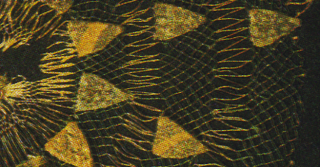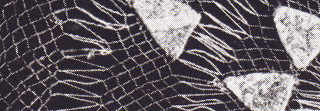A good while ago, I ran a series about medieval hairnets and netting, writing about my experiences and results from working netting both as a spiral and based on real rounds. And I wrote this:
I'd say that an unadorned, simple net might well be worked in a spiral, since it will take very hard looking to see that: In the crown section, there's too much thread on too small an area, and the lower end of the net, if stitched to a band or sporting longer loops for closure, will not be easy to read. For any net that will show different size mesh, colour changes or embroidered patterns, spirals are out of the game, because they are just irregular enough to show.
in
that post back there.
For my suspicions about nets worked in true rounds because of colour changes, different-sized mesh and embroidery, I had a prime example in mind - rolling all those treats into one beautiful hairnet that I had already
blogged about by that time - this hairnet:
I was, at that time, convinced that this so amazingly regular-looking hairnet must be made in rounds, not in a spiral.
Well.
I stand corrected, and many thanks to Cynthia, who studied the net much closer than I did. And gave me a heads-up on my error. Proof that I'm wrong (and that looking at the evidence much more closely than I did in that case is always the right thing to do) was before all of our eyes all the time, because even on that blurry picture, you can see that it was netted as a continuous spiral - if you look at the bit at around 3 o'clock:
Can you see it?
Maybe it's a bit clearer in this picture:
(This comes from HEINEMEYER, ELFRIEDE: "Zwei gotische Frauenhaarnetze." Waffen- und Kostümkunde 1 (1966): 13-22.) There's a jog right beside the upper edge of the little shield motif that is cut by the upper edge of the picture. The one without a partner by its side. And there might even be a single green thread going down from the last green bit to the next green bit, crossing right through the white bit. Which would be totally the thing to do if you couldn't be bothered to cut the green thread just for that little bit of white.
So much for netting in rounds... and I take back what I wrote, and now say:
While you might suspect that netting in the rounds would be more useful for nets with embroidery, different-sized mesh and colour changes, the busy overall pattern of such a net, made in fine threads, distracts the human eye enough from the slight irregularities of the jog that these are only seen when looking very hard or studying a net in detail.
(And now I'll wait for somebody else to prove me wrong again. Bring on your hairnet analysis results - I'm quite in the mood!)






